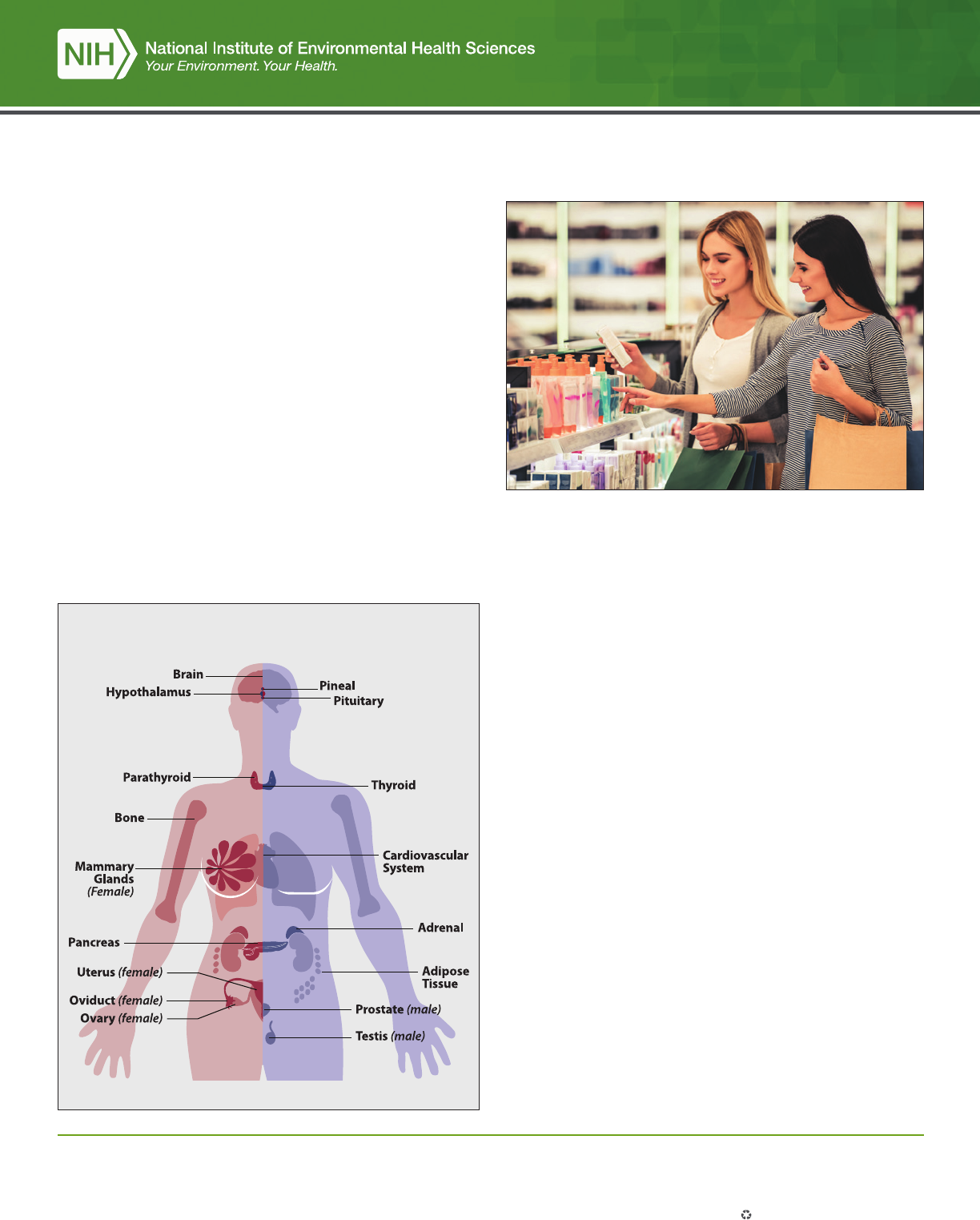
Endocrine Disruptors and Your Health
Endocrine-disrupting chemicals (EDCs) are natural or
human-made chemicals that may mimic, block, or
interfere with the body’s hormones, which are part of
the endocrine system. These chemicals are associated
with a wide array of health issues
The endocrine system
Endocrine glands, distributed throughout the body,
produce the hormones that act as signaling molecules
after release into the circulatory system.
The human body is dependent on hormones for a healthy
endocrine system, which controls many biological
processes like normal growth, fertility, and reproduction.
Hormones act in extremely small amounts, and minor
disruptions in those levels may cause signicant
developmental and biological eects.
Diagram of many of the
body's endocrine glands
Used with permission. © 2015 by the Endocrine Society.
How do we encounter these chemicals?
Endocrine disruptors are found in many everyday
products, including some cosmetics, food and
beverage packaging, toys, carpet, and pesticides.
Some chemicals that act as ame retardants may
also be endocrine disruptors. Contact with these
chemicals may occur through air, diet, skin, and water.
EDCs cannot be completely avoided or removed;
however, you can make informed choices to reduce
exposure and risk of any potential health eects.
Chemicals that may disrupt your endocrine system
According to the Endocrine Society, there are nearly
85,000 human-made chemicals in the world, and
1,000 or more of those could be endocrine disruptors,
based on their unique properties.
1
The following are
among the most common and well-studied.
Atrazine is one of the most commonly applied
herbicides in the world, often used to control weeds
in corn, sorghum, and sugarcane crops.
Bisphenol A (BPA) is used to make polycarbonate
plastics and epoxy resins. It is used in manufacturing,
food packaging, toys, and other applications. BPA
resins may be found in the lining of some canned
foods and beverages.
PO Box 12233 • Research Triangle Park, NC 27709
Phone: 919-541-3345 • https://niehs.nih.gov
March 2023
National Institutes of Health
U.S. Department of Health and Human Services
Printed on recycled paper

Dioxins are a byproduct of certain manufacturing
processes, such as herbicide production and paper
bleaching. They can be released into the air from
waste burning and wildres.
Perchlorate is a colorless salt manufactured and
used as an industrial chemical to make rockets,
explosives, and reworks, which can be found in
some groundwater.
Per- and polyuoroalkyl substances (PFAS) are a
large group of chemicals used widely in industrial
applications, such as reghting foam, nonstick pans,
paper, and textile coatings.
Phthalates are a large group of compounds used
as liquid plasticizers. They are found in hundreds of
products including some food packaging, cosmetics,
fragrances, children’s toys, and medical device tubing.
Cosmetics that may contain phthalates include nail polish,
hair spray, aftershave lotion, cleanser, and shampoo.
Phytoestrogens are naturally occurring substances
with hormone-like activity found in some plants; they
may have a similar eect to estrogen produced by the
body. Soy foods, for example, contain phytoestrogens.
Polybrominated diphenyl ethers (PBDE) are used to
make ame retardants for products such as furniture
foam and carpet.
Polychlorinated biphenyls (PCBs) were used to
make electrical equipment, such as transformers, and
are in hydraulic uids, heat transfer uids, lubricants,
and plasticizers. PCBs were mass-produced globally
until they were banned in 1979.
Triclosan is an ingredient that was previously added
to some antimicrobial and personal care products, like
liquid body wash and soaps.
National Institute of Environmental Health Sciences
National Institute of Environmental Health Sciences
What have scientists determined?
An in
dependent panel of scientic experts convened
by NIEHS and the National Toxicology Program (NTP)
concluded that there is “credible evidence” that very
small amounts of some hormone-like chemicals harmed
the organs and bodily functions of test animals.
2
This report is foundational to ongoing research.
In addition, both the Endocrine Society and the
European Society of Endocrinology have highlighted
“widespread scientic evidence” that exposure to
endocrine-disrupting chemicals is harmful to human,
animal, and ecological health.
3
Thus, it is important
to minimize exposures, identify new EDCs as they
emerge, and understand underlying mechanisms to
develop interventions.
How do they aect a body?
Researchers have gained insight into how endocrine
disruptors inuence the endocrine system and alter
hormonal functions. Given the variety of chemicals,
it is not surprising that they can act in various ways
in dierent parts of the body. Researchers have
discovered that endocrine disruptors can:
• Mimic, or partly mimic, naturally occurring
hormones in the body like estrogens (female sex
hormones), androgens (male sex hormones),
and thyroid hormones, potentially leading to
overstimulation.
• Bind to a receptor within a cell, like a key within a
lock, and block the naturally occurring hormone
from performing. The normal signal then fails to
occur, and the body does not respond properly.
Examples of chemicals that block hormones are
anti-estrogens and anti-androgens.
• Interfere or block the way natural hormones, or
their receptors, are made or handled in the body, for
example, by altering their metabolism in the liver.

Scientists are not certain how some endocrine
disrupters work, and study continues.
Assessing the public health eects of endocrine-
disrupting chemicals is dicult for several reasons.
People are typically exposed to multiple endocrine
disruptors at the same time. Early-life eects of these
chemicals may not manifest until much later in life.
And, in some cases, these eects can be persistent
and be passed down for multiple generations.
What is NIEHS doing?
NIEHS has been a pioneer in supporting and
conducting research on the health eects of
endocrine disruptors. This research leads to a
greater understanding of how endocrine-disrupting
chemicals may harm health and cause disease.
Work at NIEHS began with studies on the endocrine-
disrupting eects of the drug diethylstilbestrol (DES).
From the 1940s through the 1970s, DES was used
to treat women with high-risk pregnancies, with
the mistaken belief that it prevented miscarriage.
In 1972, prenatal exposure to DES was linked to
the development of a rare form of vaginal cancer
in daughters whose mothers took DES, and with
numerous noncancerous changes in both sons and
daughters. NIEHS experiments on DES successfully
replicated and predicted health problems, which
aided discovery of how DES may harm well-being.
Decades later, NIEHS continues work to understand
and evaluate potential endocrine disruptors. The goals
are identifying key characteristics, understanding both
individual chemicals and mixtures, and evaluating
potential health eects on humans in the areas of:
• Cancer
• Neurodevelopment
• Obesity and metabolism
• Reproduction
• Thyroid function
Within NIEHS, dierent programs support innovative
research projects on endocrine-disrupting chemicals
to uncover how they function and dene their role in
health and disease. Some areas that these researchers
are advancing include:
• Developing new models and tools to better
understand how they work.
• Improving ways to identify endocrine-disrupting
substances.
• Understanding linkages between exposures and
health eects.
• Forming strategies to reduce or prevent exposures.
They also conduct laboratory studies to prioritize
endocrine-disrupting chemicals for toxicity testing.
NIEHS is developing and applying new ways to use
robotics to predict endocrine-disrupting activity for
environmental substances. This eort will help spur
rapid testing of chemicals to better assess human
health eects of environmental exposures.

National Institute of Environmental Health Sciences
What have NIEHS and NTP discovered?
Recent NIEHS-supported research shows links between
endocrine-disrupting chemicals and the ways in
which well-being may be harmed. Examples follow.
Attention. Exposure to certain phthalates was
associated with behaviors characteristic of attention
decit hyperactivity disorder (ADHD).
4
Immunity. Children exposed to high levels of PFAS
had a diminished immune response to vaccines.
5
Other research found some indication of increased
risks of childhood infections, particularly following
exposures to PFAS.
6
Metabolism. Long-term exposure to arsenic can
disrupt metabolism, increasing the risk of diabetes
and other metabolic disorders.
7
Liver disease. A large-scale study on exposure to
PFAS in humans and rodents showed consistent
evidence of chemical-driven liver damage.
8
Other research indicated that exposure to
another endocrine-disrupting chemical, triclosan,
worsened fatty liver disease in mice that ate a
high-fat diet.
9
Puberty. Chemicals in lavender oil and tea
tree oil were associated with premature breast
development in girls,
10
and abnormal breast
development in boys.
11
Reproduction. DES can alter the way genes are
turned on and o in reproductive organs of mice,
potentially aecting fertility and reproduction.
12
BPA substitutes have also been linked to similar
reproductive issues.
13
For more information on the National Institute of Environmental Health Sciences, visit https://niehs.nih.gov.
1
Endocrine Society: Common EDCs and Where They Are Found. Available: https://www.endocrine.org/topics/edc/what-edcs-are/common-edcs
[accessed 16 February 2023].
2
National Toxicology Program. 2001. Report of the Endocrine Disruptors Low-Dose Peer Review. Research Triangle Park, NC: National Toxicology Program.
3
Gore AC, et al. 2015. EDC-2: The Endocrine Society’s Second Scientic Statement on Endocrine-Disrupting Chemicals. Endocr Rev 36(6):E1-E150.
4
Shoa JR, et al. 2020. Association of Exposure to Endocrine-Disrupting Chemicals During Adolescence With Attention-Decit/Hyperactivity Disorder-Related
Behaviors. JAMA Netw Open 3;3(8):e2015041.
5
Grandjean P, et al. 2017. Estimated exposures to peruorinated compounds in infancy predict attenuated vaccine antibody concentrations at age 5-years.
J Immunotoxicol. (1): 188–195.
6
Dalsager L, et al. 2021. Exposure to peruoroalkyl substances during fetal life and hospitalization for infectious disease in childhood: A study among 1,503 children
from the Odense Child Cohort. 149:106395.
7
Martin EM, et al. 2017. Genetic and epigenetic mechanisms underlying arsenic-associated diabetes mellitus: a perspective of the current evidence. Epigenomics.
9(5): 701–710.
8
Costello E, et al. 2022. Exposure to per- and polyuoroalkyl substances and markers of liver injury: a systematic review and meta-analysis. Environ Health Perspect
130(4):46001.
9
Yueh MF, et al. 2020. Triclosan leads to dysregulation of the metabolic regulator FGF21 exacerbating high fat diet-induced nonalcoholic fatty liver disease.
Proc Natl Acad Sci USA (49):31259–31266.
10
Ramsey JT, et al. 2019. Lavender products associated with premature thelarche and prepubertal gynecomastia: case reports and endocrine-disrupting chemical
activities. J Clin Endocrinol Metab. 104(11):5393-5405.
11
Henley DV, et al. 2007. Prepubertal gynecomastia linked to lavender and tea tree oils. N Engl J Med 356(5):479–85.
12
Li Y, et al. 2018. DNA methylation and transcriptome aberrations mediated by ERα in mouse seminal vesicles following developmental DES exposure.
Proc Natl Acad Sci U S A. 1;115(18):E4189-E4198.
13
Chen Y, et al. 2016. Exposure to the BPA-substitute bisphenol S causes unique alterations of germline function. PLoS Genet 12(7): e1006223.
